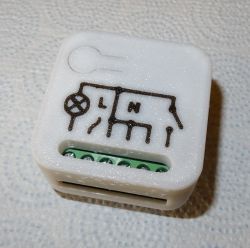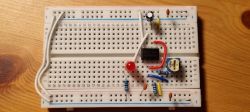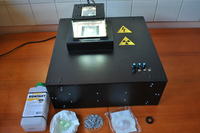
Hello,
I would like to share with you the design of the fog chamber and the experience that can be made through it.
There are a few things here that are not related to electronics, but I hope you find it interesting. In case I throw here the functional block designs of the chamber: HV generator with multi-tap duplicator, PWM lighting controller and fan power regulator and water cooling used in the project.
I also recorded a short film presenting the work of the chamber - you can see the radiation of the obtained samples and visualization of the tracks of elementary particles very nicely there.
I encourage you to watch, comment and make your own experiments!
The following text is a description of the experiment:
Fog chamber: Unusual traces of elementary particles?
The experimental demonstration is carried out using a fog chamber, called
also a diffusion chamber or Wilson chamber invented in 1900 by the Scottish physicist Charles Wilson. Thanks to this device, it was possible to observe the first tracks of elementary particles and examine them more thoroughly, for which its inventor received the Nobel Prize in 1927. It should be noted that the presented design is a diffusion chamber, which is a more modern version of the Wilson chamber which operated on the principle of gas expansion, and therefore periodically. In the diffusion chamber, alcohol vapors are supersaturated all the time, which allows continuous observation.
The experimental system that will allow observation of the phenomenon is an independent device powered from the network. The whole project was based on descriptions of chambers available on the Internet on websites such as Cloudy Labs FR, Instructables
The final version of the chamber was created from observations and a long process of improving the device. I owe the idea of making the chamber and substantive support to Dr. Adam Buczek from the Technical Physics circle at the Poznań University of Technology. The process of bringing the chamber to proper operation was of an experimental nature due to the multifactoriality of the issue and the complexity of emerging problems.
Subsequent activities examining the properties of elementary particles and describing their paths arose
based on available studies and the most important and reproducible experiences
in elementary particle physics.
Before observing the experiment, it is worth remembering the following physical phenomena and concepts for better understanding:
? Elementary particles: proton, electron, neutron
? Alpha, beta, gamma radiation
? Diffusion
? Saturated pairs
? Principle of Peltier cell operation
? Particle behavior in magnetic and electrostatic fields
? The concept of radioactivity
Due to the fact that the device has been developed to work independently after a few seconds without the need to install add-ons, internal segments that ensure such operation are very important. The experimental system of the chamber consists of:
? Server power supply 12V and 69A with voltage regulation in the range of 12-13.5V
? Lighting system with PWM control
? Constant high voltage generator with multi-tap duplicator and electrodes
1-20kV
? A water cooling block with two layers of Peltier 12V cells installed on it: 4x 12A and 4x4,5A providing 80x80 cooled surface
? Heat exchange segment: liquid cooler, pump, set of fans and temperature sensor system ensuring cell cooling
? Steam heaters in a felt casing to produce alcohol vapor
? Housing, glass chamber and control panel enabling control over device parameters
For presentation of experience you will need:
? Experimental device:? Fog chamber?
? Samples of materials showing radioactivity. A piece of uranium glass, welding electrode, filament lamp for kerosene lamps containing a track, a dismantled smoke sensor containing radioactive America.
? Dispenser with isopropyl alcohol
? Additional elements that protect against residual radiation and allow the experiment to be carried out safely: pliers, gloves, lead sheet
? Strong neodymium magnet, thin metal layers blocking particles
Working principle of the device:
To perform the experiment before commissioning, a radioactive sample should be placed at the bottom of the chamber. Then add isopropyl alcohol to the felt elements and cover the cooled surface with a glass dome. With the inclusion of the main cooling block
and the water cooling system is fed by starting to pump heat from the experimental surface to the environment. Superimposed Peltier cells with different powers, respectively 12V / 12A at the bottom and 6V / 4.5A at the top, allow you to obtain a stable temperature of -30 ° C.
In this case, the temperature difference between the cooled and cooled surfaces in the entire connection is about 70 ° C. Along with the cooling process for faster visible misting you can start heating the felt evaporators, taking care not to disturb the thermal balance and not flood the cooled surface. Supersaturated alcohol vapors appear already at -20 ° C. The additional difference should allow for good results and provide satisfying observations. When you notice condensation just above the cooled surface, you can turn on the lighting and adjust it so that you can see clearly all the disturbances.
At this stage, we can only see the blurred traces of elementary particles. The situation will change dramatically when we turn on the high voltage generator, which will clean the air inside the dome from unnecessary ions that interfere with observation. After connecting the high voltage, we can already see the sharp outlines of the paths of elementary particles. Sometimes during observation a large disturbance may appear in the form of a cloud of liquefied alcohol due to the excessive interaction of high voltage with vapors. It is a residue that should be eliminated by proper selection of high voltage values or drying of electrodes. Having good observation conditions, we can proceed to a thorough analysis of the particle paths and their fixation so that we can determine the exact parameters of the temporarily appearing particle.
Description of the occurring phenomenon:
The appearing fog is a layer of gas saturated with alcohol due to the large temperature difference between the bottom and the top of the chamber. At the beginning, saturated isopropanol vapors form at the top of the dome, which then cool down and become supersaturated. For a given temperature some maximum steam saturation is possible e.g. for alcohol, for lower temperatures these values are lower
and some of the steam should condense so that the saturation value corresponds to the given temperature.
Condensation centers are needed to condense the vapors, where droplets could form which would settle on the bottom. In the case of the chamber, the rapid temperature change does not allow for rapid condensation and the steam is kept supersaturated. Being in this state, the steam is relatively unstable. Such centers may appear in the chamber due to the ubiquitous dust and ions that are condensation seeds. Therefore, the experiment should be tried to be carried out in relatively dust-free conditions. On the other hand, to get rid of ions that interfere with observation and cause faster alcohol consumption, high voltage is applied around the cooling surface. In the case of condensation centers, i.e. dust particles or disturbances caused by e.g. a passing elemental particle, the vapor condenses rapidly showing the trace of the particle. In this way, we can visualize the movements of elementary particles that have mass and are able to cause a disturbance in alcohol vapors.
Course of experience:
Having this knowledge about the formation of particle paths, we can go to their extraordinary world and learn about their properties and various interactions with the environment. Thanks to the chamber, we will be able to observe the movements of elementary particles, as well as experimentally determine the radioactivity of the samples, the energy of the particles and their interaction with the environment. To begin with, a piece of uranium glass will be placed in the chamber, thanks to which we will be able to observe the first different paths of elementary particles. In the past, glass was stained with uranium oxide to give a greenish color. Usually in this type of objects the content of uranium ore is about 1-3%, and the radiation of the products is not life threatening. Therefore, to find out about the particles emitted during the transformation of uranium, a placed piece of glass is placed in the chamber. After a moment needed to achieve temperature equilibrium and appropriate conditions of saturated steam, we can see single and quickly appearing traces of particles. We can already see that this is a very dynamic phenomenon, and observing a single particle turns out to be difficult. To perform a more detailed analysis, you may need to freeze the frame and refer to the knowledge you have acquired.
Observation of the emission of particles by uranium glass allows us to distinguish several types of particles. For a more detailed analysis it is worth using a radioactive series, thanks to which we will find out what decay, what energy the particles are and how often we can expect it.
For uranium it should be mainly alpha decay. Relatively thick and medium length traces are usually left in a straight line by alpha particles. The significant size of the trace can be explained by the particle size that is emitted in this decay, i.e. the helium nucleus.
The size of the nucleus is much larger than the other observed particles, by
which leaves a significant mark after its passage, condensing larger amounts of supersaturated vapors. Looking at the particle paths in the chamber and their lengths, you can try to estimate their energy. According to the experiments I came across, the path length of the alpha particle was about. 3-4cm is equivalent to the approximate 5MeV energy that this particle has. The more energy a particle has, the farther it can get through the center, leaving a trace of its presence.
It is also worth noting the difficult to grasp electrons from spontaneous beta decays. The paths of these particles are extremely thin and can take a variety of shapes that reflect the chaotic movement of the electron. Usually our eyes appear as rows of individual droplets arranged in a certain shape. The thickness of the trace should not come as a surprise, as the electron is much smaller than the helium atomic nucleus, which is our reference. Despite the fearful name, we can see that the emission from uranium glass is not very common, so in this case its radiation is not strong. Which confirms the admission of this glass for everyday use.
In our observations, we must also take into account that some of the particles leaving marks in the chamber may come from outside it. The results of the experiment may be affected by radiation from other elements such as CRT TV, minerals showing residual radioactivity found in mortar, granite elements. However, the main source of external radiation is cosmic radiation. These rays of very high energy particles originating, among others from stars they penetrate or collide with our atmosphere and form bundles of various elementary particles that can also be seen
in the fog chamber. They should be treated as background radiation.
Another subject whose radioactivity we will examine and observe
in the chamber there will be a filament grid for kerosene lamps. According to the description, it contains a radioactive track, which, when heated, causes the lamp's flame to shine more strongly.
When placed in the chamber, you can immediately notice the difference in emissions. You can see many more overlapping traces and long paths indicating high energy of the registered particles. This is due to the short time of track disintegration. We are also able to notice double V-shaped decays.
This is a trace of the dynamic decay of the track into polonium, which is very unstable and rapidly transforms into lead. Each of these changes is accompanied by an alpha transformation, which we register as two adjacent straight lines.
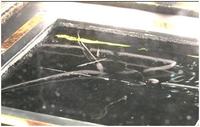
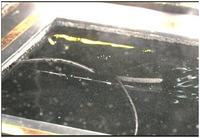
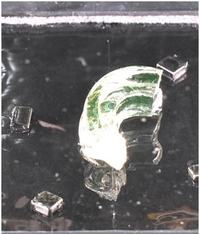
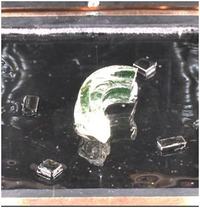
It is also worth considering the interaction of elementary particles emitted from sources
with the environment or other particles inside the chamber. These can be collisions as a result of which particles suddenly change their direction of motion. The scattering of a particle on an obstacle or the curve of its path in the presence of a magnetic field. However, the most interesting are phenomena that require a lot of luck to observe, because of their rarity. These include: annihilation of the gamma quantum, which, when hitting an alcohol or gas atom, generates an electron-positron pair, which, moving further, have curved paths in opposite directions due to opposite charges.
Electron bursting is another interesting interaction of elementary particles with atoms
from the orbits of atoms in the chamber, which can be seen through the sharp paths of particles coming out of one point in space. Interactions of this nature are very difficult to observe, but they are worth remembering.
The above examples allowed us to learn about the phenomenon of radioactivity
and made it possible to observe the paths of elementary particles as an extraordinary proof of their presence and the phenomena to which they are subject.
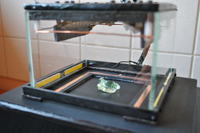
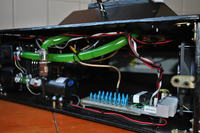
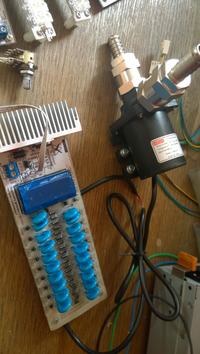
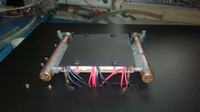
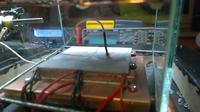




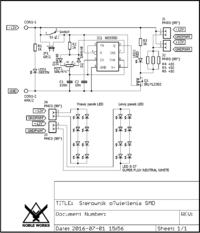
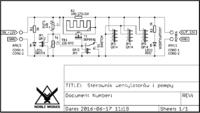
Attached are the BRD / SCH files of the project.
Cool? Ranking DIY



